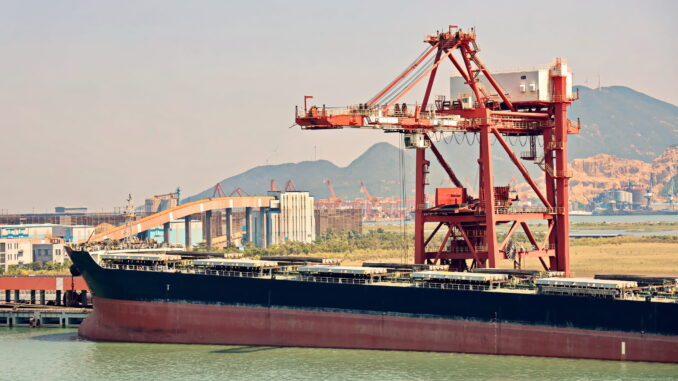
China’s LNG deal-making has been gaining momentum, even amid international calls to pull back on gas development due to greenhouse gas (GHG) emissions and methane leakage problems.
Chinese gas importers have increased long-term LNG contracts with both Qatar and the U.S., the world’s second and third largest LNG exporters, by nearly 50 percent since late 2022. These contracts account for some 40 million tonnes per annum (mtpa) of new LNG supply, according to Reuters figures. Chinese gas importers also plan to ink more long-term LNG deals with Oman, Canada and Mozambique.
China’s LNG imports also increased markedly over the past seven years, with only a brief pull back last year. Imports shot up from 72,800 million cubic metres (mcm) in 2016 to an all-time high of 162,820 mcm in 2021. In 2022, that number dropped to some 145,249 mcm.
Going forward, Chinese companies are expected to contract LNG supply of more than 100 mtpa by 2026, representing a surplus of up to 8 mtpa that year.
China’s gas importers are also starting up or expanding trading desks in London and Singapore. This is increasing China’s power as a major secondary LNG trader on the spot market in both Asia and Europe.
China goes long on LNG
China is the world’s second largest LNG importer, after conceding the top slot to Japan in 2021 due to economic contraction from the Covid-19 pandemic. It’s also the world’s third largest gas user (both LNG and pipeline gas), after the U.S. and Russia.
By 2022, gas made up 8.49 percent of China’s primary energy mix. This marks a decline from 8.67 percent in 2021, but a steady increase over the previous ten years. Gas made up only 3.75 percent of its energy mix in 2010 and 8.11 percent in 2020.
This increase comes in large part from China’s so-called coal-to-gas switching plan to try to reduce emissions, namely in its major urban centres.
The government meanwhile has been touting its ability to lower urban CO2 emissions in some 38 cities, despite growing economies and populations in these cities for the past five years. A further 21 cities have lowered emissions as their respective economies or populations have declined over the same period.
Beijing, for example, China’s capital and one of its most polluted cities, is an example. It has seen improved air quality since at least 2013, with particulate matter (PM) 2.5 levels dropping over that time period, according to an Atlantic Council report. LNG usage played a large part in emissions reductions, in addition to more pipeline gas being used.
As such, the Chinese government has also claimed that it’s on its way to reach over-all peak emissions by 2030 and net zero by 2060. State-run news agency Xinhua said recently that China is “pressing ahead on a green development path, it has made every effort to live up to its promises.”
However, these findings have to be put in context: China has 10 cities with over 10 million people, 21 cities with over five million residents, and a staggering 145 cities with over a million people. Its top three most populated cities are: Shanghai (24.5 million people), Beijing, (22.5 million) and Guangzhou, (19.8 million).
Moreover, while emissions in several Chinese cities have dropped, the country’s total emissions continued to spike over roughly the same time period, increasing from 10,011 million metric tons (MMT) in 2017 to 11,472 MMT in 2021.
“China’s CO2 emissions are still increasing and have returned to record levels,” a Carbon Brief report said. Emissions grew 10 percent year-on-year in the second quarter of 2023, rising approximately 1 percent above the record levels seen in 2021, it added. These emissions spikes come as the country opened up after more than two years of on-and-off again strict Covid-19 lockdowns over much of the country.
Climate impact
Rob Rozansky, an LNG analyst at Global Energy Monitor, told Gas Outlook that “switching from coal to gas power probably improves local air quality, but gas-fired power still produces harmful emissions linked to health impacts and premature deaths.”
The problem with gas is that it still emits at least half of the CO2 as does coal when used in power production. Moreover, methane leaks occur at every part of the gas value chain.
This includes from the well-head, during transportation along pipelines, at power plants, and also in the homes and businesses where gas is burned. Added to the fray, methane is more than 25 times as potent as CO2 at trapping heat in the atmosphere, according to U.S. Environmental Protection Agency (EPA) analysis.
Rozansky added that GHG emissions reductions from coal-to-LNG switching in China “are probably light at best, while a fleet of new LNG-fired power plants, built to operate for decades, would be out of step with international climate goals.”
Factoring in the entire LNG life cycle, and with methane gas leaks throughout the entire LNG supply chain and since methane is such a powerful GHG emitter, LNG has “an outsized climate impact,” Rozansky explained.
Moreover, the International Energy Agency’s (IEA) recent update to its Net Zero by 2050 scenario found that gas consumption for the power sector should begin to decline this decade, and that oil and gas consumption combined should be 20% lower by 2030 than it is today.



